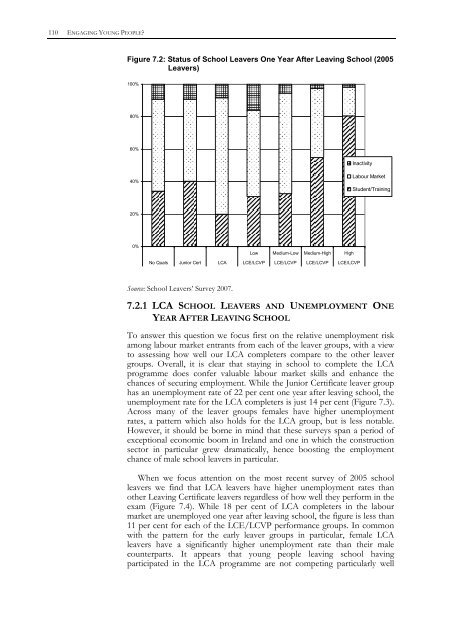Student Experiences of the Leaving Certificate Applied Programme
Student Experiences of the Leaving Certificate Applied Programme
Student Experiences of the Leaving Certificate Applied Programme
You also want an ePaper? Increase the reach of your titles
YUMPU automatically turns print PDFs into web optimized ePapers that Google loves.
110 ENGAGING YOUNG PEOPLE?Figure 7.2: Status <strong>of</strong> School Leavers One Year After <strong>Leaving</strong> School (2005Leavers)100%80%60%Inactivity40%Labour Market<strong>Student</strong>/Training20%0%Low Medium-Low Medium-High HighNo Quals Junior Cert LCA LCE/LCVP LCE/LCVP LCE/LCVP LCE/LCVPSource: School Leavers’ Survey 2007.7.2.1 LCA SCHOOL LEAVERS AND UNEMPLOYMENT ONEYEAR AFTER LEAVING SCHOOLTo answer this question we focus first on <strong>the</strong> relative unemployment riskamong labour market entrants from each <strong>of</strong> <strong>the</strong> leaver groups, with a viewto assessing how well our LCA completers compare to <strong>the</strong> o<strong>the</strong>r leavergroups. Overall, it is clear that staying in school to complete <strong>the</strong> LCAprogramme does confer valuable labour market skills and enhance <strong>the</strong>chances <strong>of</strong> securing employment. While <strong>the</strong> Junior <strong>Certificate</strong> leaver grouphas an unemployment rate <strong>of</strong> 22 per cent one year after leaving school, <strong>the</strong>unemployment rate for <strong>the</strong> LCA completers is just 14 per cent (Figure 7.3).Across many <strong>of</strong> <strong>the</strong> leaver groups females have higher unemploymentrates, a pattern which also holds for <strong>the</strong> LCA group, but is less notable.However, it should be borne in mind that <strong>the</strong>se surveys span a period <strong>of</strong>exceptional economic boom in Ireland and one in which <strong>the</strong> constructionsector in particular grew dramatically, hence boosting <strong>the</strong> employmentchance <strong>of</strong> male school leavers in particular.When we focus attention on <strong>the</strong> most recent survey <strong>of</strong> 2005 schoolleavers we find that LCA leavers have higher unemployment rates thano<strong>the</strong>r <strong>Leaving</strong> <strong>Certificate</strong> leavers regardless <strong>of</strong> how well <strong>the</strong>y perform in <strong>the</strong>exam (Figure 7.4). While 18 per cent <strong>of</strong> LCA completers in <strong>the</strong> labourmarket are unemployed one year after leaving school, <strong>the</strong> figure is less than11 per cent for each <strong>of</strong> <strong>the</strong> LCE/LCVP performance groups. In commonwith <strong>the</strong> pattern for <strong>the</strong> early leaver groups in particular, female LCAleavers have a significantly higher unemployment rate than <strong>the</strong>ir malecounterparts. It appears that young people leaving school havingparticipated in <strong>the</strong> LCA programme are not competing particularly well

















